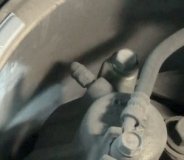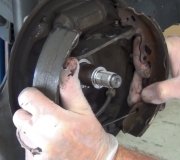Good morning.
You still have air in the system.
Do you have ABS? If you do, you need to bleed the ABS unit.
I posted bleeding for both with and without ABS.
Roy
Deplete the vacuum reserve by applying, the brakes several times with the ignition "Off". Use extreme care to prevent brake fluid from contacting painted surfaces.
1. Fill the master cylinder reservoir with brake fluid. Maintain the fluid level in the reservoir during the bleeding operation. It is necessary to have an assistant in the vehicle to press on the brake pedal during the manual bleeding procedure.
2. If the master cylinder is known or suspected to have air in the bore, then it must be bled before any wheel cylinder or caliper in the following manner:
a. Disconnect the front brake pipe connection(s) at the master cylinder.
B. Allow brake fluid to fill the master cylinder until it begins to flow from the front pipe connector port.
C. Connect the forward brake pipe(s) to the master cylinder and tighten.
D. Depress the brake pedal slowly one time and hold. Loosen the front brake pipe connection at the master cylinder to purge air from the bore. Tighten the connection and then release the brake pedal slowly. Wait 15 seconds. Repeat the sequence, including the 15 second wait, until all air is removed from the bore. Care must be taken to prevent brake fluid from contacting any painted surface. After all air has been removed at the forward connection(s), bleed the master cylinder at the rear (cowl) connection(s) in the same manner as the front.
E. If it is known that the calipers and wheel cylinders do not contain any air, then it will not be necessary to bleed them.
3. Individual wheel cylinder or calipers are bled only after all air is removed from the master cylinder.
4. If is necessary to bleed all of the wheel circuits, the following sequence should be followed:
1st - Right rear / 2nd - Left rear / 3rd - Right front / 4th - Left front
5. Raise vehicle.
6. Place a proper size box end wrench (or special tool) over the caliper/cylinder bleeder valve.
7. Attach a clear tube over the bleeder screw. Submerge the other end of the tube in a clear container partially filled with clean brake fluid.
8. Depress the brake pedal slowly one time and hold. Loosen the bleeder screw to purge air from the cylinder/caliper. Tighten bleeder screw and slowly release pedal. Wait 15 seconds. Repeat the sequence, including the 15 second wait, until all air is removed. It may be necessary to repeat the sequence 10 or more times to remove all the air. Rapid pumping of the brake pedal pushes the master cylinder secondary piston down the bore in a way that makes it difficult to bleed the system. Tighten rear bleeder screws to 7 Nm (62 inch lbs.) And front bleeder screws to 13 Nm (115 inch lbs.)
9. Lower vehicle.
10. Fill the master cylinder to the proper level.
11. Check the brake pedal for "sponginess" or excessive travel. Repeat entire bleeding procedure to correct either of these two conditions.
With ABS. You need a scan tool that will allow the solenoids to open to bleed the system.
1. Using a scan tool, select MOTOR REHOME. The motor rehome function cannot be performed if current DTCs are present. If DTCs are present, the vehicle must be repaired and DTCs cleared before performing the motor rehome function.
2. The entire brake system can now be bled.
Thursday, February 25th, 2021 AT 9:47 AM


